Bollard
A bollard is a sturdy, short, vertical post. The term originally referred to a post on a ship or quay used principally for mooring boats, but is now also used to refer to posts installed to control road traffic and posts designed to prevent ram-raiding and vehicle-ramming attacks.
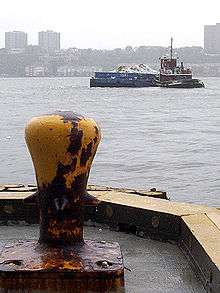
Etymology
The term is probably related to bole, meaning a tree trunk.[1][2][3] The earliest citation given by the Oxford English Dictionary (referring to a maritime bollard) dates from 1844,[1] although a reference in the Caledonian Mercury in 1817 describes bollards as huge posts.[4] Previously, simpler terms such as "post" appear to have been used. The Norman-French name boulard (still often found in Normandy) and Dutch bolder may be related.
History
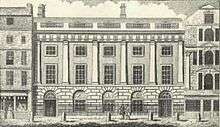
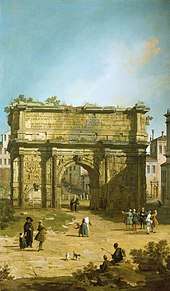
From the 17th and 18th centuries, old cannon were often used as bollards on quaysides to help moor ships alongside. The cannon would be buried in the ground muzzle-first to approximately half or two-thirds of their length, leaving the breech (rear end) projecting above ground for attaching ropes. Such cannon can still occasionally be found. Bollards from the 19th century were purpose-made, but often inherited a very similar "cannon" shape.
Wooden posts were used for basic traffic management from at least the beginning of the 18th century. An early well-documented case is that of the "two oak-posts" set up next to the medieval Eleanor cross at Waltham Cross, Hertfordshire, in 1721, at the expense of the Society of Antiquaries of London, "to secure Waltham Cross from injury by Carriages".[5] Similar posts can be seen in many historic paintings and engravings.
In the Netherlands, the Amsterdammertjes of Amsterdam were first erected in the 19th century. They became popular symbols of the city, but they are now gradually being removed and replaced with elevated sidewalks.
Types
Maritime
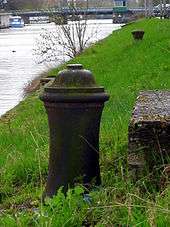
In the maritime contexts in which the term originates, a bollard is either a wooden or iron post found as a deck-fitting on a ship or boat, and used to secure ropes for towing, mooring and other purposes; or its counterpart on land, a short wooden, iron or stone post on a quayside to which craft can be moored. The Sailor's Word-Book of 1867 defines a bollard in a more specific context as "a thick piece of wood on the head of a whale-boat, round which the harpooner gives the line a turn, in order to veer it steadily, and check the animal's velocity".[1][6] Bollards on ships, when arranged in pairs, may also be referred to as "bitts".[7][8]
Mooring bollards are seldom exactly cylindrical, but typically have a larger diameter near the top to discourage mooring warps (docklines) from coming loose. Single bollards sometimes include a cross rod to allow the mooring lines to be bent into a figure eight. Small mushroom-bollards are found on lock approaches for advancing boats waiting for lock access.
A conventional measure of the pulling or towing power of a watercraft is known as bollard pull, and is defined as the measured force exerted by a vessel under full power on a shore-mounted bollard through a tow-line.
Road traffic
Roadside bollards
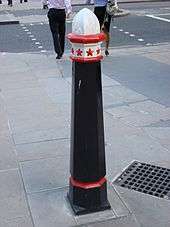
Bollards can be used either to control traffic intake size by limiting movements, or to control traffic speed by narrowing the available space. Israel's Transportation Research Institute found that putting bollards at highway exits to control traffic also reduced accidents.[9]
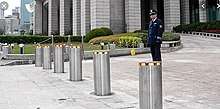
Permanent bollards can be used for traffic-control or terrorist prevention purposes.[10] They may be mounted near enough to each other that they block ordinary cars/trucks, for instance, but spaced widely enough to permit special-purpose vehicles, bicycles, and pedestrians to pass through. Bollards may also be used to enclose car-free zones. Bollards and other street furniture can also be used to control overspill parking onto sidewalks and verges.[11]
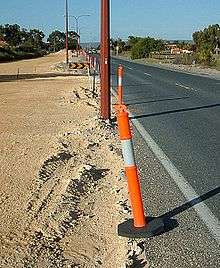
Tall (1.15 meter/4 foot) slim (10 cm/4 inch) fluorescent red or orange plastic bollards with reflective tape and removable heavy rubber bases are frequently used in road traffic control where traffic cones would be inappropriate due to their width and ease of movement. Also referred to as "delineators", the bases are usually made from recycled rubber, and can be easily glued to the road surface to resist movement following minor impacts from passing traffic. The term "T-top bollards" refers to the T-bar moulded into the top for tying tape. Bollards are regarded as an economical and safe delineation system for motorways and busy arterial roads; and, in conjunction with plastic tape, for pedestrian control.
Traffic bollards used in the US are very similar to devices found throughout the UK, with the following exceptions:
- The traffic bollard shell displays the MUTCD (Manual of Uniform Traffic Control Devices) "Keep Right" symbol (R4-7). In addition, the traffic bollard also has a yellow diamond below the "Keep Right" symbol instead of a yellow shield.
- Unlike many existing traffic bollards found in the UK, most new modern traffic bollards installed along roadways today are made of materials that make them completely collapsible. When struck by a vehicle at low or high speed, the traffic bollard shell reverts to its original position with minimal to no damage to the unit.[12]
Traffic-island bollards
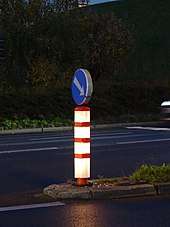
Traffic bollards are used to highlight traffic islands. They are primarily used at intersections within the splitter islands (a raised or painted area on the approach of a roundabout used to separate entering from exiting traffic, deflect and slow entering traffic, and provide a stopping place for pedestrians crossing the road in two stages)[13] and at the ends of pedestrian refuge islands, typically located at mid-block pedestrian crosswalks.
Illuminated bollards are also used to supplement street signs and street lighting to provide a visual cue to approaching drivers that an obstacle exists ahead during hours of darkness and during periods of low visibility:[14][15] (fog, rain, snow, haze, etc.) and to indicate that braking may be required. Illuminated bollards are also used in Hong Kong, a former British colony.
Internally illuminated traffic bollards have been in existence throughout the United Kingdom and Ireland since the 1930s, although the term "bollard" only seems to have been in common use since the late 1940s.[1] An illuminated bollard has a recessed base light unit in the foundation which illuminates the traffic bollard from all angles.[16] The main components are housed below the road or pedestrian surface (typically a concrete surface). Therefore, if a vehicle strikes the traffic bollard, the units below the surface are not damaged.
Reflective bollards may also be used; they need no power or maintenance, and can be built to recover to their normal position after being struck.[17]
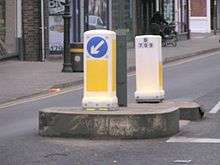
Bell
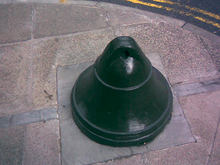
A bell bollard is a style of bollard designed to deflect vehicle tires. The wheel mounts the lower part of the bollard and is deflected by its increasing slope. Such bollards are effective against heavy goods vehicles that may damage or destroy conventional bollards or other types of street furniture.[18] A variant on the bell bollard is the "Martello bollard", its sloped shape inspired by the profile of historic Martello towers.
Removable
Bollards may be hinged at ground level, allowing them to be folded flat to permit vehicles to drive over them. In such cases they are generally fitted with padlocks at the base, to prevent being lowered without proper authorization.
Removable bollards may be fitted into a permanent metal ground socket, from which they can be removed entirely to allow traffic to pass. A polypropylene ground socket is also available that protects the paving and foundations from damage when the bollard is struck. This design uses a self-locking taper to enable bollards to be easily removed and relocated.
Retractable or "rising" bollards can be lowered entirely below the road surface (generally using an electric or hydraulic mechanism) to enable traffic to pass, or raised to block traffic. Rising bollards are used to secure sensitive areas from attack, or to enforce traffic rules that are time related, or to restrict access to particular classes of traffic.
Manually retractable bollards (lowered by a key mechanism) are found useful in some cases since they do not require retrofitting into existing landscapes, or any electrical hookups or hydraulic systems.[19]
The term "robotic bollards" has been applied to traffic barricades capable of moving themselves into position on a roadway.[20]
Self-righting or self-recovering bollards can take a nudge from a vehicle and return to the upright position without causing damage to the bollard or vehicle. They are popular in car park buildings and other areas of high vehicle usage.[21]
Flexible
Flexible bollards are bollards designed to bend when struck by vehicles. They are typically made from synthetic plastic or rubber that is stiff on its own, but pliable under the weight of a car or truck. When struck, flexible bollards give way to some extent, reducing damage to vehicles and surrounding surfaces, and return to their original, upright position. Some flexible bollards do not provide physical protection from vehicles; rather they offer clear visual guidance for drivers. Other flexible bollards have been designed to provide physical protection as well as reduced damage by incorporating strong elastic materials. These can be all plastic or plastic/steel hybrids but combine varying degrees of stopping power and flexibility.[22][23][24][25]
Racing
Some forms of motorsport use removable, high-visibility bollards on road courses and street courses to mark the apex of certain corners. They are used to deter cutting a corner too tightly and violating track limits: in most racing series, drivers may incur a penalty for colliding with or driving inside these bollards.
Racing bollards are very lightweight and built to break off at the base when hit so as to not damage the vehicle; this feature of bollards makes them favored over "sausage kerbs"—also used to prevent cutting corners—which are elevated rigid structures that run along the inside of a turn. In contrast to bollards, sausage kerbs are much more unforgiving, and vehicles that hit them can be severely damaged or launched airborne upon contact.
Covers
A more recent development in bollard technology are bollard covers. They are used by many industries and communities as a cost-effective way to increase safety and refresh old and worn-out-looking bollards without having to completely replace the original bollard. They slip over the existing bollard and can come in a variety of shapes and styles. Because they are easily removable, they can be replaced quickly, and depending on their material they may never need painting and are resistant to scratching and other wear and tear. Traffic bollard covers are typically made of tough recycled plastic and have high-visibility colours to ensure motorists see them. Decorative bollards are used in street areas to enhance display and may come with LED lights to increase visibility and safety at night.
Protective
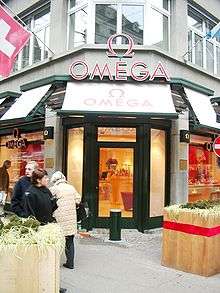
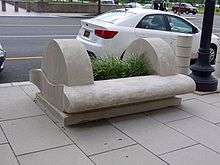
Bollards are used by government agencies and private businesses to protect public spaces, buildings, and the people in them from car ramming attacks.[26] They usually consist of a simple steel post either anchored to concrete, cored into a hard surface, buried in the ground or secured on a self-locking taper or impact recovery system to protect the surrounding foundations when a bollard is struck.
These bollards protect utilities, electronics, machinery, buildings, or pedestrians from accidental collisions by vehicles, including passenger vehicles, transport trucking, and fork lifts. As collisions can cause damage to vehicles, operators, or the bollards themselves, new bollards have been developed that absorb some of the impact energy, lessening the violence of the collision. Some are made of forgiving plastics while others are made of steel but fitted with an elastomer to absorb the impact energy.[27]
Bollards are widely used to contribute to safety and security. The American Bar Association (ABA) states that bollards are used to contribute to homeland security.[28] The American National Institute of Building Sciences site—the Whole Building Design Guide (WBDG)—recommends in its Design Guidance that open spaces surrounding and contiguous to buildings be included as integral parts of a security design.[29]
There are two main kinds of security-related bollard:
- non-crash-resistant bollards
- crash- and attack-resistant bollards, a hardened barrier systems used to protect military, governmental and other buildings or compounds of higher security levels.[30] They are often used by retailers to prevent "ram-raiding" burglaries. Large concrete planters are a decorative alternative to traditional bollards.
According to the National Institute of Building Sciences, non-crash-resistant bollards are "perceived impediments to access" and address the actions of two groups.
- Law-abiding persons who comply with civil prescriptions of behavior as defined by the manner in which bollards are put to use;
- Potentially threatening and disruptive persons for whom bollard applications are proscriptive by announcing their behavior is anticipated, and that additional levels of security await them.[31]
Rising bollards are increasingly common around the world to hinder vehicle-based terrorist actions from achieving close proximity to buildings, and are also used to prevent terrorist vehicle-ramming attacks such as the 2007 Glasgow International Airport attack. They are also useful in mixed-use public spaces, which support both pedestrian use and emergency or service vehicle use. These bollards are usually priced between $11,000 to $100,000 depending on their ability to resist ramming vehicles, based on speed and size of the vehicle. The most expensive bollards can stop vehicles at speeds of about 50 mph (80 km/h).
High security bollards are impact-tested in accordance with one or more of three major crash test ratings for vehicle barriers. These are PAS 68 (UK),[32] IWA-14 (International) and ASTM (US).[33][34] Such bollards are used for hostile vehicle mitigation and are designed to protect against potential vehicle borne improvised explosive devices (VBIED) and vehicle as a weapon (VAW) attacks such as those seen in the Nice attack in 2016 and the Westminster Bridge attack in 2017.
Bollard sleeves in various alloys or finishes are designed to cover security bollards to enhance their visual attractiveness.[35]
U-shaped bollards are typically used for the protection of equipment and are very common in areas that need coverage over a wider area than of a normal bollard, such as fuel stations and bike lanes.[36]
Dragon's teeth
Large concrete structures called dragon's teeth were invented during World War II to slow down, stop or channel enemy tanks.
Lights
Bollard lights are a type of architectural outdoor lighting fixture comprising short, upright ground-mounted units, typically giving off light from the top or the sides, and used to illuminate walkways, steps or pathways.
Solar bollards store energy during daylight hours in order to illuminate during night. They use either a photocell or algorithms that determine whether the solar cells are receiving light to determine when to illuminate.
Other applications
The National Clearinghouse for Educational Facilities (NCEF), managed by the National Institute of Building Sciences (NIBS), cited three dozen applications of bollards.[37][38] The following list of open areas is encompassed by the ABA, NCEF and WBDG recommendations:
- Playgrounds
- Trails/Trailheads
- Roadways
- Leisure Parks
- Fire Access Lanes
- Building Setbacks
- Sports Field
- Malls
- Traffic Gates
- Landscapes
- Pathways
- Site Utilities
- Bus Em/Debarkation
- Toll Booth
- Bicycle Lane
- Traffic Medians
- Site Perimeters
- Intersections
- Store Fronts
- Building Hardening
- Vehicle Parking
- Site Access Control
- Site Surveillance
- Vehicle Pick-Up
In fire emergencies
According to the International Fire Code (IFC-2009) and the American National Fire Protection Association Fire Code 1 (NFPA-1) all new buildings or renovated buildings must have fire access roadways to accommodate fire apparatus and crews and other first responders. Thus the choice of bollard styles must apply to the NFPA's Code 1710. Bollards are now designed in terms of how long it takes to remove or collapse them to allow first responders entry to the access roadway.[39][40][41]
Architectural design functions
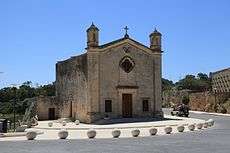
Listed below are the building design objectives and requirements under fire or security related instances on campuses and their relationship to the use of bollards according to the Association of Higher Education Facilities.[42]
- Accessible: fire lane bollards will accommodate persons using wheelchairs
- Aesthetics: the fire lane and its bollard style complements surrounding landscape design
- Cost-Effective: fire lane system life cycle costing
- Functional/Operational: Building architect determines if entrances to building envelope can accommodate first responders or whether entrances require retrofitting, and authority having jurisdiction and first responders determine if the fire lane can readily be accessed through the bollards under emergency conditions
- Historic Preservation: City planner address the special needs in historic districts and of historic buildings to accommodate fire lanes and bollards.
- Productive: The HR officer comments on felt security of those working in the protected building, and all first responders pass on their ability to perform under fire mitigation conditions
- Secure/Safe: Input by building safety or security officer and representative first responders to assure hallways and stairwells can accommodate first responders and that the fire lane is free of all obstructions 24/7
- Sustainable: Landscape architect and surveyor comment on long term sustainability of area impacted by fire lane and use by first responders.
Artwork
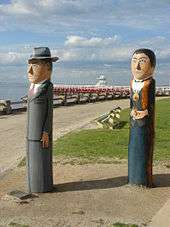
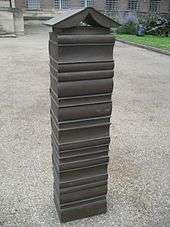
In Geelong, Victoria, Australia, decorative bollards, sculpted and painted by Jan Mitchell, are placed around the city to enhance the landscape as a form of outdoor public sculpture. Usually they are made of timber, minimally modified from the traditionally cylindrical, wooden, maritime bollard shape, but brightly painted to resemble human figures. Such figures – which may be historical or contemporary, particular or generic – are sited singly or in clusters along the waterfront and in other areas where people gather. Decorative bollards have become a well-known feature of the city of Geelong and reflect its history as a major Australian port.[43]
In Antwerp, Belgium, artist Eddy Gabriel transformed a bollard to look like a toadstool in 1993. This example was followed by other artists, turning the quayside of the river Scheldt into a street art gallery.[44]
In Norwich, England, a set of 21 bollards was installed in 2008 in the Lanes area north of City Hall, designed by artist Oliver Creed and commissioned by the City Council as part of a regeneration programme.[45] They are coloured "madder red", in reference to the red dye extracted from the madder plant and used for dying cloth, one of the city's major industries during the 16th century; and they bear bronze finials also alluding to local history. 10 of these depict the madder plant, while the other 11 have unique designs, usually relevant to the specific location in which the bollard is placed, including a scene of sheep-shearing, a Green Man, a swan's head in Swan Lane, and so on.[46]
On the forecourt of Cambridge University Library, England, a line of 14 bronze bollards made to resemble piles of books was installed in 2009. This work, Ex Libris, was created by sculptor Harry Gray. The ten outer bollards are static, but the "books" making up the four central bollards can be swivelled, so that the lettering on their spines aligns to form the Latin phrase Ex Libris ("from/out of the books"), commonly used on bookplates.[47][48][49]
Many other towns, such as Winchester, England and Pristina, Kosovo, have painted ordinary bollards in unusual decorative patterns. See the "External links" section for pointers to Wikimedia Commons for examples.
Gallery
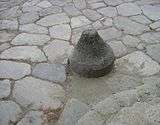 Ancient Roman bell bollard in Herculaneum, Italy
Ancient Roman bell bollard in Herculaneum, Italy- Old cannon used as bollard, outside the church of St Helen's Bishopsgate, London
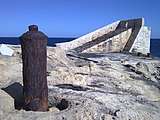 Old cannon used as a mooring bollard, near the entrance of the Grand Harbour, Malta
Old cannon used as a mooring bollard, near the entrance of the Grand Harbour, Malta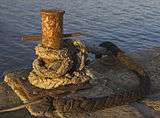 Mooring bollard, Lyme Regis
Mooring bollard, Lyme Regis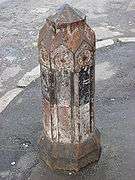 Late 19th or early 20th-century bollard in Spitalfields, east London
Late 19th or early 20th-century bollard in Spitalfields, east London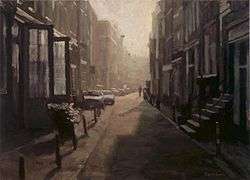 Amsterdammertjes in an Amsterdam street, in the painting Backlight Langestraat (1993) by Frans Koppelaar
Amsterdammertjes in an Amsterdam street, in the painting Backlight Langestraat (1993) by Frans Koppelaar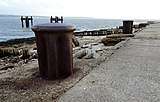 Mooring bollards at Lepe Beach, Hampshire, England, installed in 1944 for the use of craft destined to take part in the D-Day landings
Mooring bollards at Lepe Beach, Hampshire, England, installed in 1944 for the use of craft destined to take part in the D-Day landings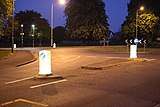 Internally illuminated bollards direct traffic in England
Internally illuminated bollards direct traffic in England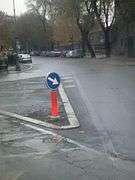
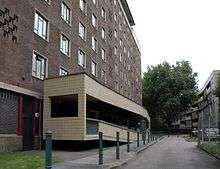 Bollards separating pavement from roadway at the Spa Green Estate, Clerkenwell, London
Bollards separating pavement from roadway at the Spa Green Estate, Clerkenwell, London- Stainless steel bollards
 Manually retractable bollard at Battery Park, New York City
Manually retractable bollard at Battery Park, New York City- A removable metal bollard out of its socket in London
- Rising bollards can retract to allow passage of streetcars in Sofia, Bulgaria
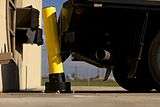 Truck collision with a rebounding bollard
Truck collision with a rebounding bollard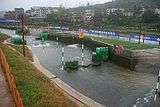
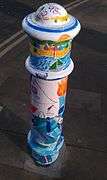 Decorated bollard in Winchester, England
Decorated bollard in Winchester, England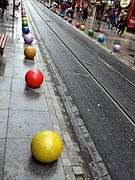 Cannonball-shaped bollards in Istanbul, Turkey
Cannonball-shaped bollards in Istanbul, Turkey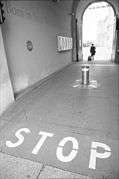 Museumsquartier Vienna
Museumsquartier Vienna
See also
References
- "bollard, n.". Oxford English Dictionary (3rd ed.). Oxford University Press. September 2005. (Subscription or UK public library membership required.)
- New Shorter Oxford English Dictionary, 1993
- "Online Etymology Dictionary". Etymonline.com. Retrieved 26 October 2013.
- Caledonian Mercury. 19 July 1817. Missing or empty
|title=(help) - Boulting, Nikolaus (1976). "The law's delays: conservationist legislation in the British Isles". In Fawcett, Jane (ed.). The Future of the Past: attitudes to conservation, 1174–1974. London: Thames & Hudson. p. 13. ISBN 978-0-8230-7184-5.
- Chris Roberts, Heavy Words Lightly Thrown: The Reason Behind Rhyme, Thorndike Press, 2006 (ISBN 0-7862-8517-6)
- "bitt, n.". Oxford English Dictionary (3rd ed.). Oxford University Press. September 2005. (Subscription or UK public library membership required.)
- Herwadkar, Nihar (5 March 2019). "10 ship terms and definitions even smart people misuse". Marine Insight. Retrieved 5 June 2019.
- Driver behaviour and accident records at unsignalized urban intersections. Abishai Polusa, Department of Civil Engineering & Transportation Research Institute, Technion-Israel Institute of Technology, Haifa 32000, Israel. June 1984. Available online 4 July 2002.
- https://slate.com/news-and-politics/2017/08/bollards-are-our-best-defense-against-the-use-of-vehicles-as-weapons.html
- "Pavement parking". Department for Transport. Archived from the original on 8 April 2010. Retrieved 25 July 2009.
- "Striking a Bollard". Simmonsigns.co.uk. Archived from the original on 3 March 2012. Retrieved 26 October 2013.
- U.S. Department of Transportation: "Roundabouts:An Informational Guide", FHWA-RD-00-067, 2000
- "Road Traffic Signs and Internally Illuminated Bollards. Specification for Internally Illuminated Bollards", British Standards Institution, 1980
- Philip Weber, Scott Ritchie: "Internationally Recognized Roundabout Signs", Paper for the Transportation Research Board National Roundabout Conference, 2005
- Simmonsigns, Simbol Product Specifications, 2006
- "Surrey County Council – Reflective bollards on traffic islands". Surreycc.gov.uk. Archived from the original on 30 October 2013. Retrieved 26 October 2013.
- "Bell Bollard". Furnitubes International. Retrieved 18 May 2015.
- "Urban Park Bollard". Archived from the original on 27 October 2009.
- "Robotic Bollards to Take Control". BBC News. 28 April 2004.
- "Reboundable bollard With Fixings". Bollard Shop. Retrieved 26 October 2013.
- "REDUCING DAMAGE FROM VEHICLE-BOLLARD IMPACTS" (PDF).
- "Flexible Bollard with Steel Core".
- "Bollards".
- "Bollards & Goal Posts".
- "Do bollards offer protection against vehicle attacks?". DW. 8 March 2018. Retrieved 8 April 2018.
- Oakes, Charles. "PhD". Blue Ember Technologies, LLC. Retrieved 3 October 2012.
- Ernest B. Abbott and Otto J. Hetzel, "Homeland Security Begins at Home: Local Planning and Regulatory Review to Improve Security", in Rufus Calhoun Young, Jr. and Dwight H. Merriam, A Legal Guide to Homeland Security and Emergency Management for State and Local Governments, American Bar Association, 2006
- "Space Types | Whole Building Design Guide". Wbdg.org. Retrieved 12 June 2012.
- Security for Building Occupants and Assets, Whole Building Design Guide Archived 15 March 2011 at the Wayback Machine, 14 December 2010.
- Oakes, Charles G. "The Bollard: Non-Crash and Non-Attack-Resistant Models | Whole Building Design Guide". Wbdg.org. Retrieved 26 October 2013.
- "BSI PAS 68". Retrieved 5 April 2019.
- "ASTM F2656 / F2656M - 18a Standard Test Method for Crash Testing of Vehicle Security Barriers". www.astm.org. Retrieved 5 April 2019.
- "Hostile vehicle mitigation | Public Website". www.cpni.gov.uk. Retrieved 5 April 2019.
- "Bollards stainless pipe fabrication". Shawfab.com. Retrieved 26 October 2013.
- "Bollard Guide". TKObollards.com.au. Retrieved 5 June 2018.
- "NCEF Assessment Guide : Outdoor Athletic Facilities and Playgrounds" (PDF). Ncef.org. Archived from the original (PDF) on 29 October 2013. Retrieved 26 October 2013.
- "NCEF Assessment Guide : School Grounds and Site Access Control" (PDF). Ncef.org. Archived from the original (PDF) on 29 October 2013. Retrieved 26 October 2013.
- Oakes, Charles G. "Bollard design for trails and fire protection". Americantrails.org. Archived from the original on 18 May 2011. Retrieved 26 October 2013.
- "Bollards, NYC" (PDF). Retrieved 7 November 2012.
- Transportation Alternatives: Rethinking Bollards–How Bollards Can Save Lives, Prevent Injuries and Relieve Traffic Congestion in New York City. July 2007
- Charles G. Oakes, Whole Building Design Objectives for Campus Safety and Security: A Systems Dynamics Approach, Facilities Manager, July/August, 2010, pp 21-26
- "Geelong Bollards". Angelfire.com. Retrieved 26 October 2013.
- witzenstein (24 July 2007). "Witzenstein: Who told you not to believe in fairytales?". Witzenstein.blogspot.com. Retrieved 12 June 2012.
- Cocke, Richard (2013). Public Sculpture of Norfolk and Suffolk. Public Sculpture of Britain. 16. Liverpool: Liverpool University Press. pp. 64–5. ISBN 978-1-84631-712-5.
- Reynolds, Leo (16 December 2007). "Norwich Bollards: full set of photos of bollard finials". flickr. Retrieved 15 June 2013.
- "Cambridge University Library Forecourt. Cambridge. 2009". Harry Gray. Retrieved 29 May 2015.
- Beard, Mary (11 September 2009). "A Don's Life: Is it a bollard? Is it a sculpture? Is it a book?". TLS: The Times Literary Supplement. Archived from the original on 6 June 2015. Retrieved 29 May 2015.
- Greer, Germaine (4 January 2010). "My favourite library is being transformed into a beacon of naffness". The Guardian. Retrieved 29 May 2015.
External links
| Wikimedia Commons has media related to |
